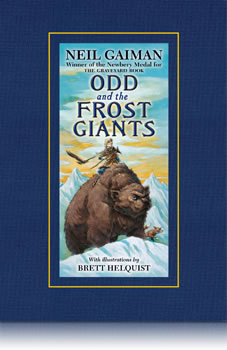
Living in a village in ancient Norway, twelve-year-old Odd has had his share of bad luck: his father died in an expedition to Scotland; a tree fell on him and shattered his leg, leaving him lame; his mother married a man who has no use for him; and to top it off, winter is not retreating, leaving everyone grumpy and ill-tempered.
Odd’s luck changes when he decides to run away from home. Taking shelter in his father’s old woodcutting cabin, he meets a fox, a bear, and a one-eyed eagle who are not quite what they seem, but they know why spring isn’t coming. They need help to reconquer Asgard, the home of the gods, from the Frost Giants, and one cheerful, clever, plucky boy is just the help they need.
Inspired by Norse mythology, this short, fun, yet thought-provoking novel is a quick read, accompanied by the rich drawings of Brett Helquist. Highly recommended.
A Digression on Norse Mythology
I have always loved Norse mythology after encountering it as a teenager though Edith Hamilton’s Mythology. While she does a fantastic job with Greek and Roman mythology, she gives short to North mythology, as indeed most authors do (notable exceptions are those who write fantasy). Perhaps it is because Norse mythology is so much darker than Greek mythology (which is not without its dark moments, although they are rare) and especially Roman mythology, which is light and playful by comparison. Writers looking to retell these stories tend to prefer to the Roman writers for their sources, turning only to the Greeks when the Romans do not suffice. The Romans were the most removed from the original sources; for many of them, especially the later Roman writers, these really were myths, stories to be told and retold and reshaped in the telling to please an audience. This was not so for the Greeks, who were not as far removed from the sources. Certainly for Homer and Hesiod, the earliest of Greek writers, these were sacred stories, not myths. But they too, eventually viewed these tales as myths, or perhaps allegories that could be played around with.
This is not so with Norse mythology. The Poetic Edda is serious stuff; The Elder Edda even more so. Even in Beowulf, written by an anonymous poet who was nominally Christian, we can hear the beating heart of person who took these pagan tales very seriously indeed. In fact, because Christianity displaced the Norse religion at its height, these myths were not myths to the early converts, but sacred stories. These stories never lost their serious style, and never devolved into mere entertainments, as classical mythology did in Roman times.
That very seriousness leaves very little wiggle room for modern writers. You have to take these tales at face value, as Hawthorne, Bulfinch, and Hamilton did. To play around with these myths takes a sure and steady hand, which is what Neil Gaiman has. This is a deft, light-hearted adaptation of Norse mythology which is accessible to children without losing the serious tone of the original myths. I hope he tries his hand at this again, and soon.
Links
On MouseCircus, Neil Gaiman’s website for kids, you can read more about this book, or you can go to his other web site, where you can read about lots of other stuff. You can go to Brett Helquist’s website, where you can see some of the other stuff he’s done.
If you want to buy some books on Norse mythology, here is a page on Amazon that lists over 900 of them. If you want some more information on Norse mythology, there is some good information here and here.
Gaiman, Neil. Odd and the Frost Giants. Illus. Brett Helquist. New York: Harper-HarperCollins, 2009.
https://bookblog.kjodle.net/2011/04/05/odd-and-the-frost-giants-neil-gaiman/

I forgot to mention that this book was written for World Book Day, which we don’t have in the States, unfortunately. You can read more about it at the World Book Day official homepage.